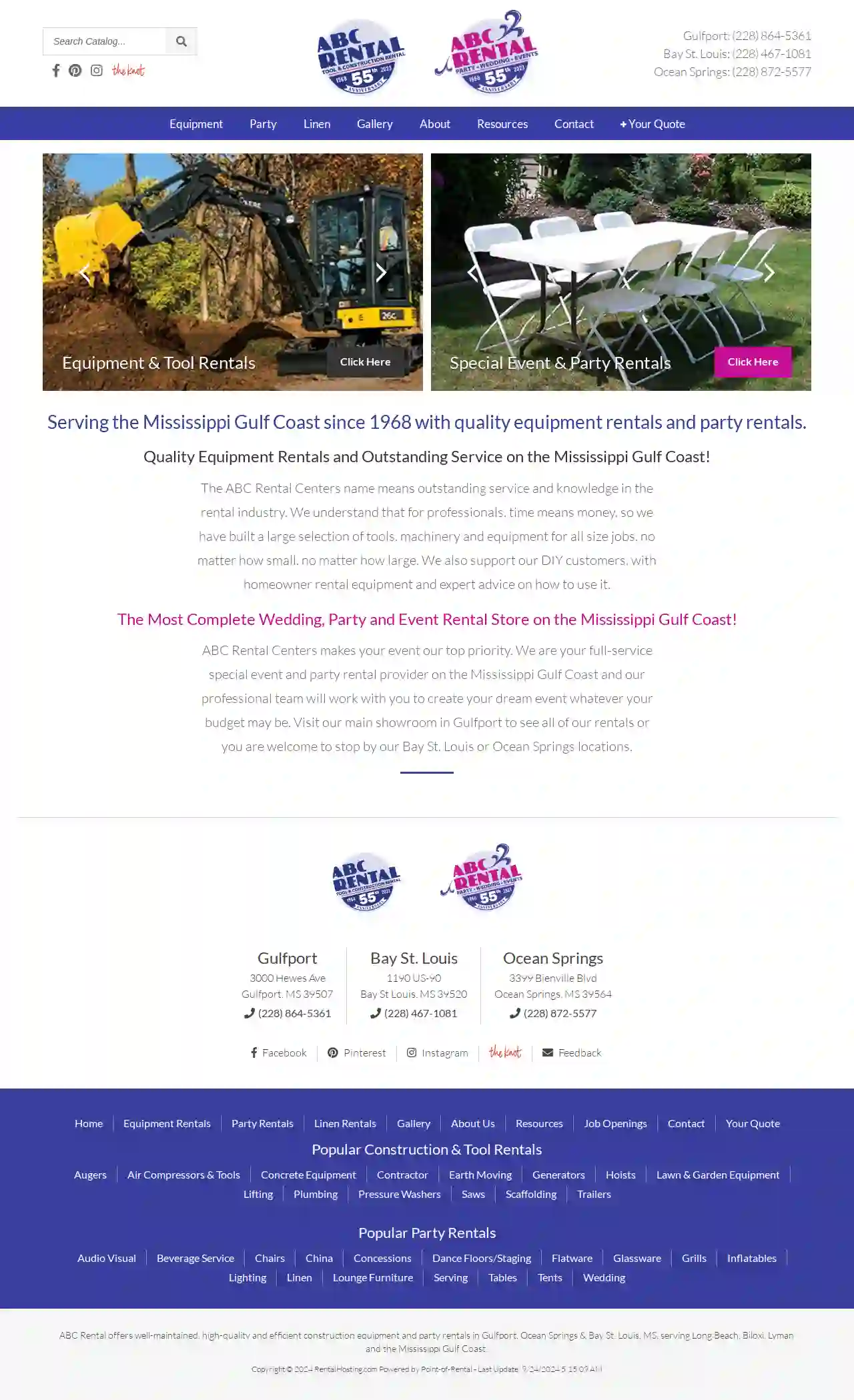Scaffolding Rental Greenville
Top Temporary Scaffolding in Greenville
Receive multiple Temporary Scaffolding quotes for your project today! Compare profiles, reviews, accreditations, portfolio, etc... and choose the best offer.
Service Needed
City or Town

ABC Rental Center
4.4151 reviews3399 Bienville Blvd, Ocean Springs, 39564, USABC Rental offers well-maintained, high-quality and efficient construction equipment and party rentals in Gulfport, Ocean Springs & Bay St. Louis, MS, serving Long Beach, Biloxi, Lyman and the Mississippi Gulf Coast. With a wide range of equipment and party rentals, ABC Rental is dedicated to providing outstanding service and knowledge in the rental industry.
- Services
- Why Us?
- Gallery
Get Quote- Ma
Magnolia Masonry of South Mississippi LLC
4.914 reviewsGulfport, US- Services
- Why Us?
Get Quote - Th
The Home Depot
4.2Gulfport, US- Services
- Why Us?
Get Quote - Cr
Crom Equipment Rentals Inc
Gulfport, US- Services
- Why Us?
Get Quote - Lo
Lowe's Home Improvement
4.1Gulfport, US- Services
- Why Us?
Get Quote
Over 2,353+ Scaffolding Companies in our network
Our scaffolding experts operate in Greenville and surroundings!
ScaffoldingHQ has curated and vetted the Best Scaffolding Companies arround Greenville. Find the most trustworthy pro today.
Frequently Asked Questions About Scaffolding Rental
Get answers to common questions about scaffolding rentals and finding the right scaffolding rental company in the USA.
- Small Repairs or Painting: A rolling tower or mobile scaffolding is often sufficient for smaller projects, providing a stable platform at lower heights.
- Roof Work: Roofing projects typically require taller and more robust scaffolding, like tube and clamp or system scaffolding.
- Two-Story Homes: For accessing higher levels of a two-story home, you may need a larger system scaffolding structure.
- Limited Access: If space is restricted, consider a narrow-width scaffolding tower or suspended scaffolding.
- Base Plates and Adjusters: Use adjustable base plates to level the scaffolding legs on uneven surfaces.
- Ground Preparation: Level the ground as much as possible before erection.
- Bracing and Support: Additional bracing and support may be necessary to compensate for uneven ground conditions.
- Professional Assessment: A qualified scaffolding erector should assess the ground and determine the appropriate measures for safe erection.
- Clean and Dry: Clean the scaffolding components thoroughly and allow them to dry completely before storage.
- Rust Prevention: Apply a rust inhibitor to metal components, especially if they will be stored outdoors.
- Organized and Labeled: Store components in an organized manner, labeling them clearly for easy identification.
- Covered Storage: Store scaffolding in a dry, covered area, protected from the elements.
- Off the Ground: Elevate the scaffolding components off the ground using pallets or racks to prevent moisture damage.
What type of scaffolding is best for home use?
The best type of scaffolding for home use depends on the project:
Can I use scaffolding on uneven ground?
Scaffolding can be erected on uneven ground, but it requires careful planning and adjustments to ensure stability:
Can I modify or alter the scaffolding after it's erected?
Do NOT modify or alter the scaffolding in any way without consulting the scaffolding rental company or a qualified scaffolding engineer. Any unauthorized modifications can compromise the structural integrity and safety of the scaffolding. If you need to make changes to the scaffolding configuration, contact the rental company. They can advise on safe adjustments or make the modifications themselves.
What are some tips for storing scaffolding?
Proper storage is essential for maintaining the quality and lifespan of scaffolding:
What type of scaffolding is best for home use?
The best type of scaffolding for home use depends on the project:
- Small Repairs or Painting: A rolling tower or mobile scaffolding is often sufficient for smaller projects, providing a stable platform at lower heights.
- Roof Work: Roofing projects typically require taller and more robust scaffolding, like tube and clamp or system scaffolding.
- Two-Story Homes: For accessing higher levels of a two-story home, you may need a larger system scaffolding structure.
- Limited Access: If space is restricted, consider a narrow-width scaffolding tower or suspended scaffolding.
Can I use scaffolding on uneven ground?
Scaffolding can be erected on uneven ground, but it requires careful planning and adjustments to ensure stability:
- Base Plates and Adjusters: Use adjustable base plates to level the scaffolding legs on uneven surfaces.
- Ground Preparation: Level the ground as much as possible before erection.
- Bracing and Support: Additional bracing and support may be necessary to compensate for uneven ground conditions.
- Professional Assessment: A qualified scaffolding erector should assess the ground and determine the appropriate measures for safe erection.
Can I modify or alter the scaffolding after it's erected?
Do NOT modify or alter the scaffolding in any way without consulting the scaffolding rental company or a qualified scaffolding engineer. Any unauthorized modifications can compromise the structural integrity and safety of the scaffolding. If you need to make changes to the scaffolding configuration, contact the rental company. They can advise on safe adjustments or make the modifications themselves.
What are some tips for storing scaffolding?
Proper storage is essential for maintaining the quality and lifespan of scaffolding:
- Clean and Dry: Clean the scaffolding components thoroughly and allow them to dry completely before storage.
- Rust Prevention: Apply a rust inhibitor to metal components, especially if they will be stored outdoors.
- Organized and Labeled: Store components in an organized manner, labeling them clearly for easy identification.
- Covered Storage: Store scaffolding in a dry, covered area, protected from the elements.
- Off the Ground: Elevate the scaffolding components off the ground using pallets or racks to prevent moisture damage.